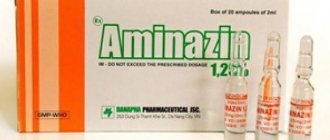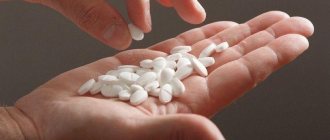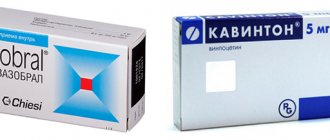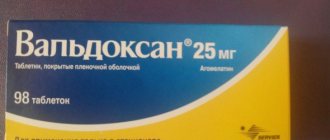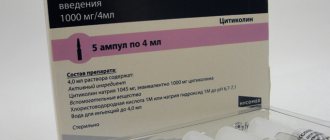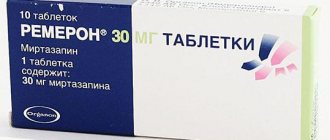This medicine belongs to the category of antioxidant drugs. It is used primarily to treat neurological pathologies. Mexidol injections according to the instructions for use contribute to:
- improvement of metabolic processes;
- regeneration of cell structure.
These properties make it possible to ensure stabilization of the patient’s psycho-emotional background. The medicine is prescribed only for the treatment of adult patients.
Share
Tweet
Share
Cool
Send
Release form and composition
The drug is produced in the form of an injection solution. It is sold in glass ampoules with a volume of 2 or 5 ml. The active ingredient of the drug is ethylmethylhydroxypyridine succinate. The amount of this active substance in 1 ml of liquid is 50 mg.
Additional components of the drug are:
- sodium metabisulfite;
- injection water.
pharmachologic effect
The active substance of the drug provides the following effects:
- Antihypoxic. There is an increase in cellular resistance during oxygen starvation of the body.
- Membranoprotective. The drug protects blood cell membranes from negative destructive factors, free radicals, and endogenous toxins.
- Nootropic. The product protects cells of the entire nervous system when exposed to unfavorable factors due to a lack of oxygen supply to the blood.
- Anticonvulsant. The medicine blocks increased pulsation of a pathological nature in the neurons of the motor centers of various structures of the nerve system.
- Anxiolytic. The medication improves brain functionality, suppresses feelings of anxiety and attacks of fear.
The presence of therapeutic effects of Mexidol ensures the following tasks:
- normalization of proper metabolism at the cellular level in the nervous system;
- improving the rheological parameters of blood, thereby reducing its viscosity;
- reducing the process of platelet adhesion;
- decreased enzyme intoxication when pancreatitis is diagnosed;
- significant improvement in metabolic processes in the heart muscle.
A similar result is achieved by increasing ethylmethylhydroxypyridine succinate, which promotes the activity of a special enzyme, superoxide dismutase. Mexidol injections help improve the adaptation capabilities of the human body under the negative influence of stressful situations.
Pharmacodynamics
Mexidol® is considered an inhibitor of free radical processes, a membrane protector with antihypoxic, stress-protective, nootropic, anticonvulsant and anxiolytic effects. The drug will increase the body's resistance to the effects of various damaging factors (shock, hypoxia and ischemia, cerebrovascular accidents, intoxication with alcohol and antipsychotics (neuroleptics).
The mechanism of action of Mexidol® is due to its antioxidant, antihypoxic and membrane protective effects. It inhibits lipid peroxidation, increases the activity of superoxide dismutase, increases the lipid-protein ratio, reduces membrane viscosity, and increases its fluidity.
Mexidol® modulates the activity of membrane-bound enzymes (calcium-independent phosphodiesterase, adenylate cyclase, acetylcholinesterase), receptor complexes (benzodiazepine, GABA, acetylcholine), which enhances their ability to bind to ligands, helps preserve the structural and functional organization of biomembranes, neurotransmitter transport and improve synaptic transmission.
Mexidol® will increase the content of dopamine in the brain. Causes an increase in compensatory activation of aerobic glycolysis and a decrease in the degree of inhibition of oxidative processes in the Krebs cycle under hypoxic conditions with an increase in the content of ATP and creatine phosphate, activation of the energy-synthesizing functions of mitochondria, stabilization of cell membranes. The drug improves metabolism and blood supply to the brain, improves microcirculation and rheological properties of blood, and reduces platelet aggregation. Normalizes the membrane structures of blood cells (erythrocytes and platelets) during hemolysis. It has a lipid-lowering effect, lowers the content of total cholesterol and LDL.
The anti-stress effect is expressed in the normalization of post-stress behavior, somatovegetative disorders, restoration of sleep-wake cycles, impaired learning and memory processes, reduction of dystrophic and morphological changes in various structures of the brain.
Mexidol® has a pronounced antitoxic effect in withdrawal symptoms. It eliminates the neurological and neurotoxic manifestations of acute alcohol intoxication, restores behavioral disorders, autonomic functions, and is also able to relieve cognitive impairment caused by long-term use of ethanol and its withdrawal.
Under the influence of Mexidol®, the effect of tranquilizing, neuroleptic, antidepressant, hypnotics and anticonvulsants is enhanced, which makes it possible to reduce their dosages and reduce side effects.
Mexidol® improves the functional state of ischemic myocardium. In conditions of coronary insufficiency, it increases collateral blood supply to the ischemic myocardium, helps maintain the integrity of cardiomyocytes and maintain their functional activity. Well restores myocardial contractility in case of reversible cardiac dysfunction.
Indications for use
Mexidol injections according to the instructions are used for adults in the treatment of pathological processes and their prevention. Using medicine for prevention, a person manages to protect the body from the appearance of somatic diseases before expected stressful events. When a person is actively affected by stressors, the medication will help minimize their negative impact, protecting cardiomyocytes from overload.
If it is impossible to avoid negative phenomena, the medicine is prescribed in the following situations:
- ischemia of cardiac tissue;
- consequences of TBI;
- dystonia;
- damage to the soft tissue of the brain (mild lesions);
- encephalopathy of various types;
- neurogenic and mental disorders;
- asthenia;
- open-angle glaucoma;
- purulent-necrotic phenomena affecting the peritoneal organs.
Important! This medicine is not used to treat childhood diseases. Reliable positive clinical achievements confirming the safety of this medication in childhood have not been established. Mexidol is also not recommended for use in the treatment of pathologies in women carrying a child and during lactation.
Contraindications for use
The drug should not be used in the following situations:
- acute renal or hepatic inflammatory processes;
- severe allergy to the composition of the medicine;
- high blood pressure;
- bronchial asthma.
Some patients experience unpleasant discomfort after injections:
- itching;
- dry mouth;
- gagging;
- nausea;
- fatigue;
- notice redness on the skin;
- drowsiness;
- significant metallic taste inside the mouth;
- apathetic state.
Directions for use and doses
Mexidol, according to the instructions for use, should be administered by injection intramuscularly or intravenously only in hospital settings. Intravenous use of the medication is carried out through a slow stream for 5–7 minutes or by drip, with preliminary dissolution of the medication in a special physiological solution.
The daily dose of the drug is about 1200 mg. The choice of regimen, as well as the dosage of using liquid for injection, depends only on the severity of the ongoing pathological process. For adults, the maximum dose per day is 1.2 g. For prophylactic purposes, the medicine is administered only intramuscularly.
To stop the acute phase of the pathological condition, a drip is prescribed (the medication is administered intravenously with preliminary dissolution in physiological solution). Subsequently, maintenance therapy is prescribed using intramuscular injections.
The duration of the therapeutic course depends on the progression of the inflammatory reaction:
- If there is a disruption in the blood supply to the brain cells, the drug is administered at a dose of 0.2-0.5 g 2-4 times daily during the first 2 weeks. Over the next 2 weeks, the drug is prescribed in a dosage of 0.1-0.25 g no more than 3 times a day.
- In acute ischemia of cardiac tissue, the drug is used as part of the main course of treatment. In the very first 5 days, the drug is administered intravenously, very slowly, after which injections are performed into the muscle for the next 9 days. The dose of the drug is selected according to the diagnosis and weight of the patient. The dose is from 2 mg/kg to 3 mg/kg of the patient’s body weight per dose.
- For TBI, a two-week course of 0.2-0.5 g of medication is administered intramuscularly in the mornings and evenings.
- For discirculatory encephalopathy, the drug is used only in the acute phase - 0.2-0.5 g. In some cases, the course is continued up to 2 times a day for 2 weeks. Injections are given into a vein. Subsequently, reduce the dose to 0.1-0.25 g per day intramuscularly. If it is necessary to carry out a preventive course of DEP, the medication is administered in a dosage of 0.2-0.25 g for two weeks by intramuscular injection.
- In case of poisoning with antipsychotics, the medicine is administered only intravenously. Daily dosage is 0.2-0.5 g. Therapy is continued for about 14 days.
- Treatment of glaucoma involves the use of intramuscular injections for 2 weeks.
- Traumatic brain injuries require complex therapy - use an intravenous drip of 200-500 mg up to 4 times a day. The course is continued for 10-15 days.
- For the treatment of acute peritonitis, the dosage is selected strictly individually; everything in this situation depends only on the neglect of the process. The drug is used before and after surgery in order to achieve a lasting clinical effect. The medicine is withdrawn gradually, with a slow reduction in the dose used over a certain period.
- If you feel constant anxiety, intramuscular injections are recommended in a dosage of 100-300 ml once a day. Therapy takes 10-30 days.
- For a hangover in a chronic alcoholic, the medicine is used intramuscularly and an intravenous drip of 200-500 mg is prescribed up to three times a day. Therapy is continued for 7 days.
- For acute edematous pancreatitis, the medicine is used 3 times a day, 200-500 ml. It is administered intravenously through a drip, and intramuscular injections are also given.
- For mild necrotic lesions of the pancreas, the medication is prescribed 100-200 ml three times a day intravenously through a dropper or intramuscularly.
- With a similar diagnosis, but in the middle stage of damage to the pancreas, the treatment regimen involves using 200 ml three times a day by drip.
- In case of a severe pathological process (necrotizing pancreatitis), the dosage of the substance is 800 ml 2 times on the very first day, and then it is reduced to 200-500 ml.
- In a situation with myocardial infarction in the acute stage, Mexidol is used in complex therapy.
The medication is administered intravenously and also intramuscularly for two weeks simultaneously with traditional therapy for the disease. It includes the use of nitrates, thrombolytics, beta-blockers, antiplatelet and anticoagulant drugs, angiotensin-converting enzyme inhibitors. At the same time, medications are prescribed according to indications, depending on the symptoms.
In the very first 4-5 days, in order to achieve maximum effect, Mexidol must be administered intravenously, after (another 9 days) it is allowed to be injected intramuscularly. The drug is delivered into the vein through a dropper, slowly (to prevent side effects). If necessary, jet injection is allowed (slow only). Injections are given strictly every 8 hours.
The daily therapeutic dose is 6-9 mg/kg of the patient’s body weight per day. Accordingly, the single dose is three times less. The maximum dose allowed is 800 mg per day, and no more than 250 mg at a time.
How is the drug used?
Methods of using Mexidol are different and are determined by the doctor. The specialist knows in what form to recommend Mexidol, what the injections help with, and in which case tablets should be preferred.
Options for using the medicine:
- intravenously
- intramuscularly
- inside
The dosage of the drug is prescribed and adjusted by the doctor in each specific case. In severe conditions, treatment begins intravenously or intramuscularly, subsequently replacing injections with tablets.
The drug is successfully used in pediatrics, including for the treatment of newborns and premature babies suffering from brain lesions, as well as for traumatic brain injuries in children. Treatment is carried out under the supervision of a doctor.
Benefits of injection
Having carefully studied the instructions for using this wonderful drug, the patient will find there valuable information about possible complications due to self-prescription and use of injections of this drug. The drug Mexidol should be used only after receiving a qualified prescription from the attending physician, who will monitor changes in the dynamics of the clinical picture.
The advantage of the intravenous use of this medication is the rapid achievement of a therapeutic effect, since the active substance immediately penetrates the blood. When administering the drug by drip, it is possible to retain the substance in its high concentration inside the bloodstream for an hour, or even longer.
Intramuscular injection of Mexidol has lower effectiveness, since the active component goes through several stages of metabolism. Accordingly, the effect of the medication will be somewhat weaker. Jet administration of the medicine is practically in no way inferior to dripping in terms of therapeutic properties.
Interaction
There are no special instructions regarding the combination of Mexidol with other drugs intended to eliminate somatic problems.
The simultaneous use of tablets and the ethyl product has a neutralizing effect on toxins.
When complex treatment, it is necessary to take into account that Mexidol has an enhancing effect on the action of the following groups of drugs:
- antidepressants;
- antiparkinsonian and anticonvulsant drugs;
- benzodiazepines;
- anxiolytics.
Mexidol has good compatibility with other drugs and can be used as part of complex drug therapy. However, it should be remembered that Mexidol can enhance the effect of anxiolytics, antidepressants, and anticonvulsants. The drug softens the toxic effects of alcohol on the body.
Side effects
The digestive system is capable of reacting to the use of such a drug with the appearance of nausea, especially dry oral mucosa. Drowsiness and mild allergic reactions are possible.
The drug solution in the situation of parenteral administration is well tolerated by patients. Only sometimes nausea and some dry mouth are possible. Allergies during therapy are also possible. It is characterized by skin rash, itching, and urticaria (a special type of rash similar to when a person is burned by nettles).
Important! If you take the medication using excessive therapeutic doses, drowsiness develops. The appearance of additional side effects becomes a compelling reason to immediately stop taking the medication.
Pharmacokinetics
Rapidly absorbed when taken orally. When taken orally in doses of 400–500 mg, Cmax is 3.5–4 mcg/ml. Quickly distributed in organs and tissues. The average retention time of the drug in the body when taken orally is 4.9–5.2 hours.
Metabolized in the liver by glucuron conjugation. 5 metabolites have been identified: 3-hydroxypyridine phosphate - formed in the liver and, with the participation of alkaline phosphate, breaks down into phosphoric acid and 3-hydroxypyridine; 2nd metabolite - pharmacologically active, formed in large quantities and found in urine 1–2 days after administration; 3rd - excreted in large quantities in the urine; 4th and 5th - glucuron conjugates.
T1/2 when taken orally - 2–2.6 hours. It is quickly excreted in the urine, usually in the form of metabolites and in small quantities unchanged. It is excreted most intensively during the first 4 hours after taking the medicine. Urinary excretion rates of unchanged drug and metabolites have individual variability.
special instructions
Sometimes, especially among patients predisposed to attacks of bronchial asthma and having increased sulfite sensitivity, the development of dangerous hypersensitivity reactions cannot be ruled out.
When starting to use the injection solution, you should especially carefully study the instructions for the drug in order to understand why Mexidol injections are prescribed.
There are several fundamental guidelines regarding the use of the medicine, which you must pay close attention to:
- With increased sulfite sensitivity, diagnosing bronchial asthma, the drug can provoke a complex allergic reaction. It is expressed by angioedema complicated by Quincke's edema. This is the name given to severe swelling of the facial tissues and genitals. At the same time, there is a real danger of developing anaphylactic shock, which is a syndrome of pronounced reactive drop in systemic blood pressure.
- There is no verified information about the safety of the drug in relation to pregnant women, minor children, and mothers breastfeeding their newborn. Because of this, the use of the drug for the treatment of these categories of patients is not recommended. Only sometimes is such a prescription performed by the attending physician, when the expected dose of the active substance received does not exceed the existing risk of developing a dangerous disease.
- The solution for parenteral administration cannot be used in cases of observed functional renal or hepatic failure.
- The medication enhances the effectiveness of anticonvulsants (Carbamazepine), Benzodiazepine, as well as antiparkinsonian (Levodopa) drugs.
- After taking the medicine, it is not recommended to perform any work that requires a person to increase the speed of psychomotor reactions and concentrate attention due to possible drowsiness.
Pharmacy kiosks dispense a solution intended for parenteral use and only with a medical prescription. It is forbidden to use it independently when you do not have a doctor’s prescription.
Interaction with other drugs
Although the medicine reduces the toxic effect of ethyl alcohol, this does not at all mean a recommendation to actively drink alcohol, and then inject this drug in order to prevent the negative consequences of drinking. The drug potentiates the activity of its derivatives: Levodopa, Carbamazepine and benzodiazepine.
Overdose
The only risk of overdose is the development of hypersomnia syndrome. This is dangerous if you need to drive a vehicle or perform actions that require special concentration and tension.
Analogues of Mexidol injections
The number of drug analogues is small, although they are produced. The drugs Medomex, Mexiprim and Mexipridol, Astrox and Armadin, as well as Mexicor are as close as possible in terms of therapeutic effects, as well as composition.



